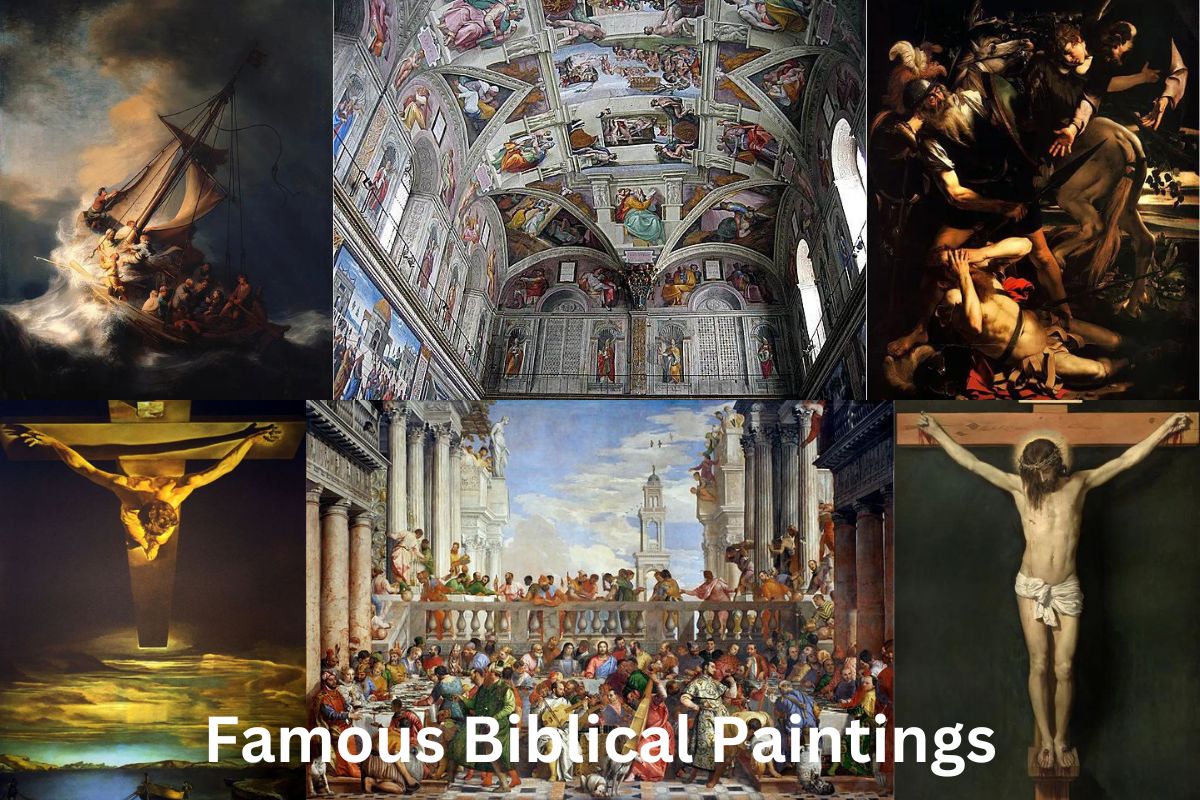Biblical paintings are works of art that depict tales, characters, or events from the Bible. They can be seen in churches and other religious institutions.
Biblical paintings have been made by a great number of prominent artists over the course of several centuries. These paintings, which are both beautiful and thought-provoking, continue to inspire and captivate viewers even in the modern day.
There are examples of biblical art housed in places of worship, museums, and private collections all across the world.
The life of Jesus, the tales from the Old Bible, and the lives of the saints are only some of the common topics that are shown in works of biblical art.
The purpose of many works of art in the Bible is to either communicate religious doctrines or to encourage introspection and meditation.
Famous Biblical Paintings
1. The Return of the Prodigal Son – Rembrandt
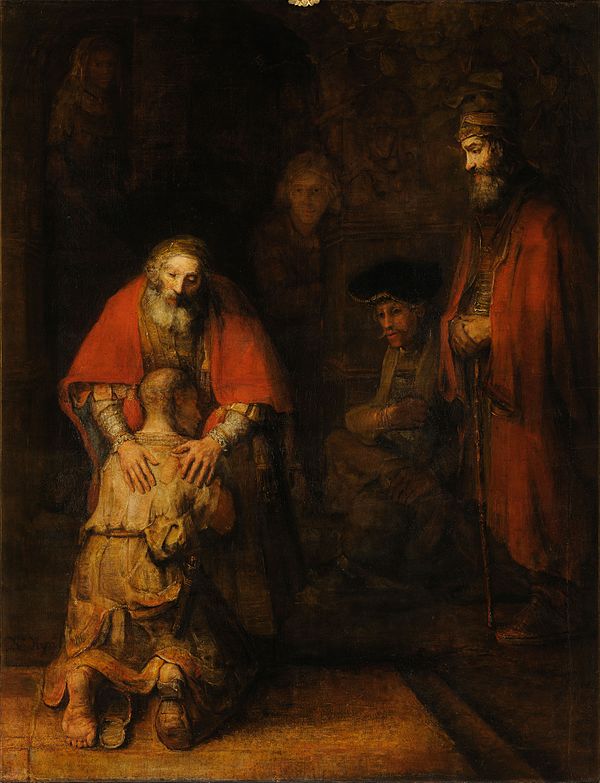
Rembrandt van Rijn was famous for the realism of his paintings, especially the contrast between bright and dark. One of Jesus’ most famous parables, “The Return of the Prodigal Son,” is depicted in his painting.
The painting was finished by Rembrandt in 1669, and since then, it has received praise from art connoisseurs and critics for its evocative quality and meticulous attention to detail.
The Biblical prodigal son leaves his father’s home with his early inheritance, only to return years later, destitute and begging to be allowed back into the family home as a servant since he no longer considers himself worthy of his father’s honor.
To his astonishment, his father welcomes him home with open arms and celebration, while another son returns to find his father clearly despising him.
The scene of the Prodigal Son’s return to his father, where he begs for forgiveness at his feet, is shown beautifully in this piece of art. The father is calming down his child while the angry sibling watches.
2. Christ of Saint John of the Cross – Salvador Dalí
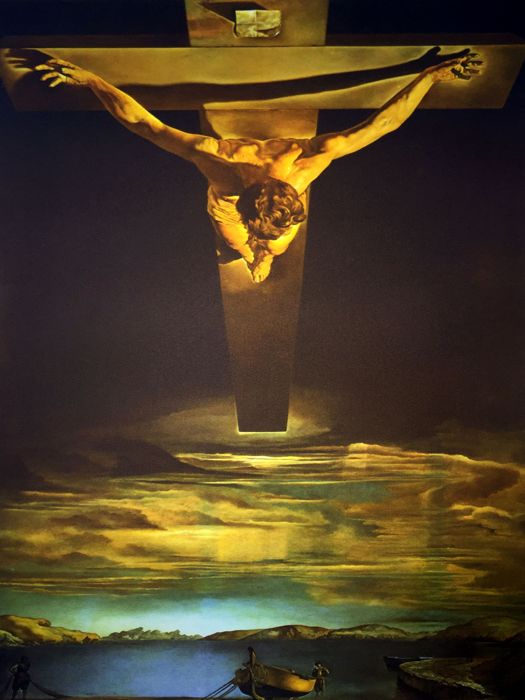
Christ of Saint John of the Cross is located in the collection of the Kelvingrove Art Gallery and Museum in Glasgow, Scotland. It was painted by in 1951.
It’s midnight, and Jesus is hanging on a cross above some water; in the distance, there’s a fishing boat and a fisherman.
After having a dream in which he was convinced that showing the nails, blood, and crown of thorns would detract from his image of Christ, Dali decided to leave them out of his crucifixion painting.
Christ’s very obtuse angle in the artwork was also explained to him in the dream.
In order to study the human form from the appropriate vantage point and visualize the effects of gravity, Dal hanged Hollywood stuntman Russell Saunders from a gantry above the studio so that he could make a likeness of Christ.
The bay of Port Lligat, where Dali was residing at the time, inspired the water in the painting.
3. Virgin of the Rocks – Leonardo da Vinci
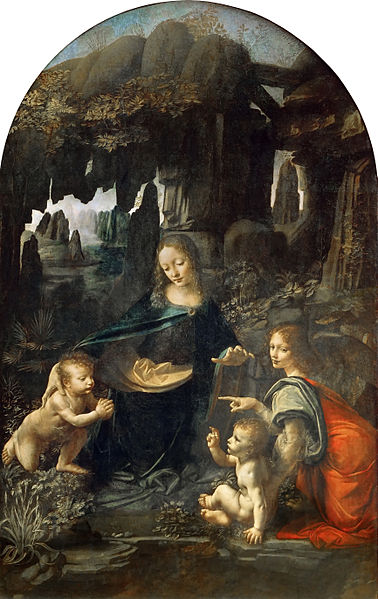
There are two versions of the Virgin of the Rocks by Da Vinci. It should be noted that the aforementioned Version 1 is now on display in the Louvre and is widely regarded as the “primary version” (the first or earliest).
A second version, also titled Virgin of the Rocks, can be exhibited in the London National Gallery.
The Louvre’s oil on wood panel version was transferred to canvas by French restorer Fr. Hacquin in 1806.
Angels playing musical instruments appear in two further paintings by Leonardo’s partners that are also related to the project. There are examples of both in London’s National Gallery.
The Madonna and Child, along with Jesus, John the Baptist, and an angel, are frequently depicted against a rocky backdrop in these images, hence the name. Except for those two little adjustments, all of the ingredients can be substituted.
The right hand and the right eye of the angel have undergone significant morphological modifications. Subtle differences exist between the versions in the Louvre and the National Gallery, including those in color, lighting, flora, and Leonardo’s use of sfumato.
4. The Conversion of Saint Paul – Caravaggio
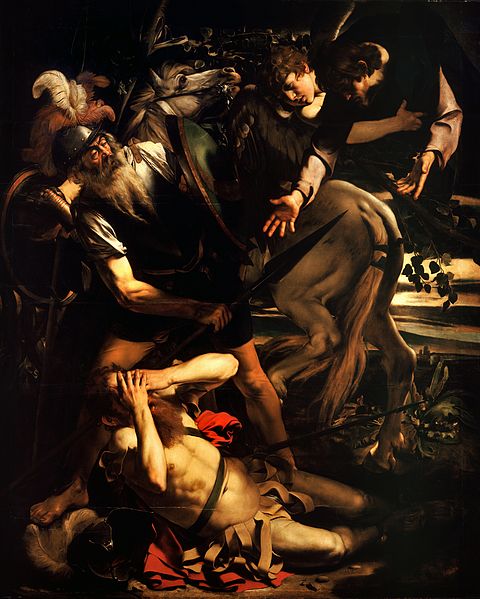
The Italian artist Caravaggio created “The Conversion of Saint Paul” (also known as “The Conversion of Saul”), which is now housed at the Odescalchi Balbi Collection in Rome.
At least two of Caravaggio’s paintings depict Paul’s conversion. The other is “The Conversion of Saint Paul on the Road to Damascus,” which may be found in the Cerasi Chapel of Santa Maria del Popolo.
Saul of Tarsus, on his way to Damascus to destroy the Christian community there, is struck blind by a blinding light and hears the voice of Christ saying, “I shall see you in Damascus.” Paul cried out to Saul, “Saul, Saul, why do you persecute me?”
Some of the people I was with saw the light and were frightened by it, but they did not hear the voice. (Acts 22:6-11).
Elsewhere To support his claim to apostleship, Paul asks rhetorically, “Have I not seen Jesus Christ our Lord?” (Paul claims to have experienced a vision in which he encountered Christ. (Verse 1 of Chapter 9)
5. Christ Crucified – Diego Velázquez
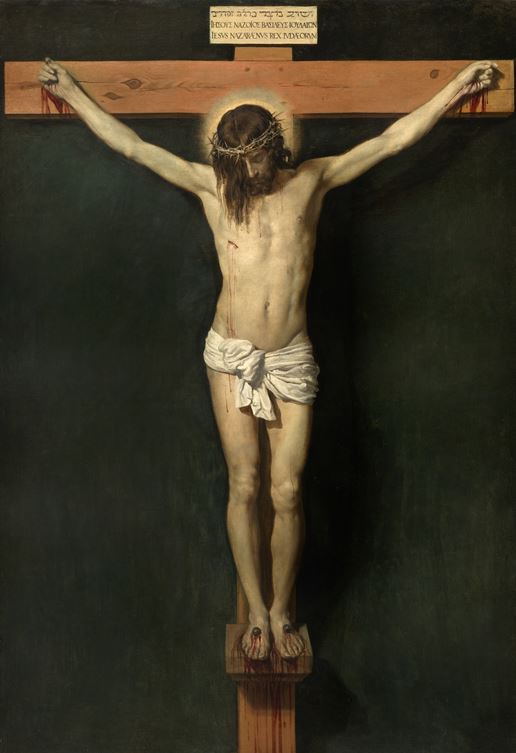
Spanish artist Diego Velazquez finished his iconic Christ on the Cross painting in 1632.
Among Diego Velazquez’s religious commissions for King Philip IV of Spain, this is one of his most well-known secular works.
In comparison to the artist’s previous works from the same time period, this depiction of the crucifixion of Jesus is much more muted.
Velazquez’s nude studies from Rome are featured in a number of his later works, such as Apollo at the Forge of Vulcan and Joseph’s Tunic.
However, Christ is portrayed more realistically, melancholically, and solemnly during his crucifixion.
When looked at closely, the only thing that can be seen on the canvas is an almost lifelike naked picture staring back at the viewer.
It is generally agreed that the artist finished the piece in Spain after returning from Italy in 1631, despite the fact that there is evidence of early sittings with live models.
The Museum of the Prado in Madrid is where you can see it right now.
6. The Wedding at Cana – Paolo Veronese
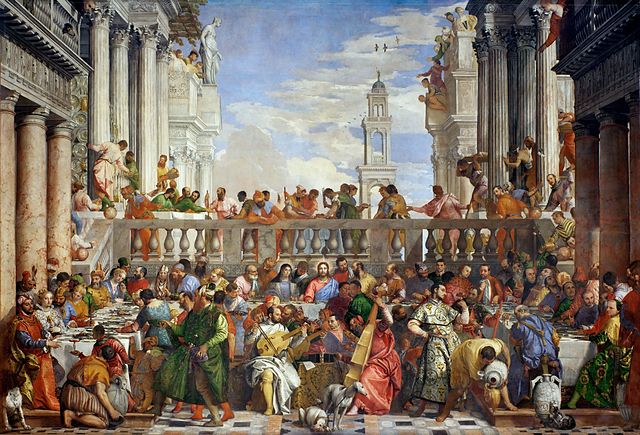
The biblical account of Jesus changing water into wine is depicted realistically in Paolo Veronese’s The Wedding Feast at Cana.
Artists like Leonardo, Raphael, and Michelangelo, who worked in the Mannerist style of the late Renaissance (1520-1600), sought to achieve compositional harmony, as seen in this massive oil painting (6.77 m x 9.94 m).
The Renaissance principles of form, light, and color were exaggerated in Mannerism, which resulted in a flattening of the visual space and a distortion of the human figure meant to convey the artist’s ideal preconception of the subject rather than a realistic rendering.
Human figures of ideal proportions, balanced composition, and beauty were central to the works of the high Renaissance (1490–1527).
Technical trickery, use of sophisticated cultural norms, and symbolism (social, religious, and theological) all combine in Veronese’s The Wedding Feast at Cana to depict a biblical story accessible to Renaissance and modern spectators.
Painting hung in monastic refectory from the 16th to the 18th century. The painting was looted as war booty in 1797, when Napoleon’s French Revolutionary Army was fighting in Italy during the French Revolutionary Wars (1792-1802).
In terms of canvas size, The Wedding Feast at Cana is the most impressive work in the Musée du Louvre’s collection (67.29 m2).
7. The Storm on the Sea of Galilee – Rembrandt
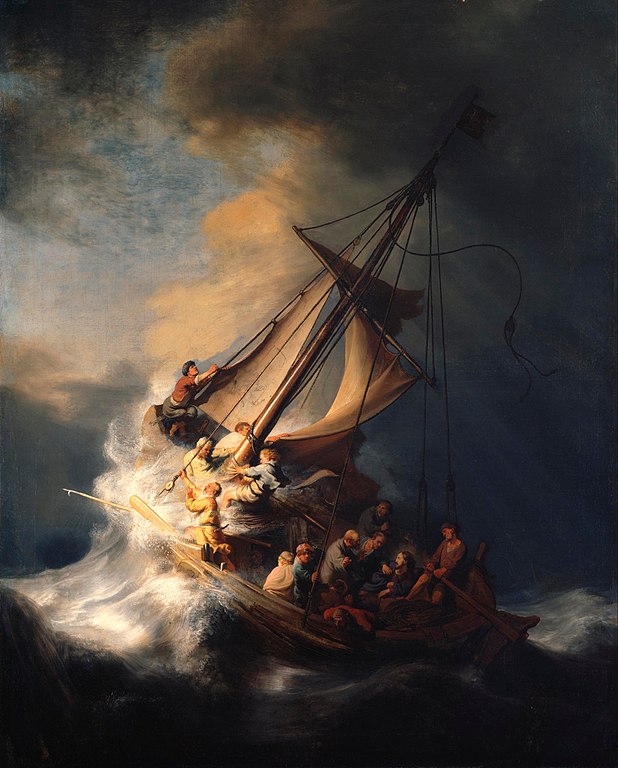
The Storm on the Sea of Galilee, Rembrandt’s lone seascape, was stolen from the Isabella Stewart Gardner Museum in Boston.
This depiction is based on Mark 4:35-41, which tells the story of Jesus stilling the storm on the Sea of Galilee.
The vertical composition of the artwork provides a tight look at Christ’s followers as they fight to regain command of their fishing boat in the midst of a violent storm.
A huge wave crashes at the bow and rips the sail. Over the wall, one of the followers is seen vomiting. One more depicts the artist looking out at the viewer directly. Only Christ (on the right) can keep his cool under pressure.
The picture is a focal point of the 2021 American documentary miniseries This Is a Robbery: The World’s Greatest Art Heist on Netflix, which recounts the March 18, 1990 heist of the Isabella Stewart Gardner Museum.
8. Sistine Chapel ceiling – Michelangelo
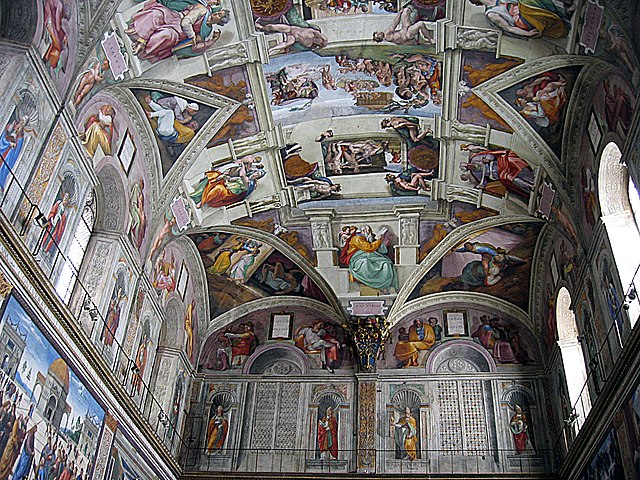
The centerpiece work on the Sistine Chapel ceiling, The Creation of Adam, is more well-known than the other paintings, although the entire ceiling is more spectacular.
The IVolta della Cappella Sistina, or Sistine Chapel ceiling, was painted by Michelangelo between 1508 and 1512. The finest ideals of the Renaissance period are reflected in this work of art.
Julius II, Pope, commissioned the murals for the ceiling. Even now, the chapel serves as the site of papal conclaves and other major events.
Of the nine episodes represented there, the most well-known is probably Adam’s creation from the Book of Genesis.
Michelangelo’s mastery of the human form is on full show in this intricate pattern, which features groups of clothed and unclothed people in a wide variety of poses and has served as an invaluable source of inspiration for artists ever since.
Michelangelo finished the massive work by painting while lying flat on his back from scaffolding placed beneath the ceiling.
9. The Incredulity of Saint Thomas – Caravaggio
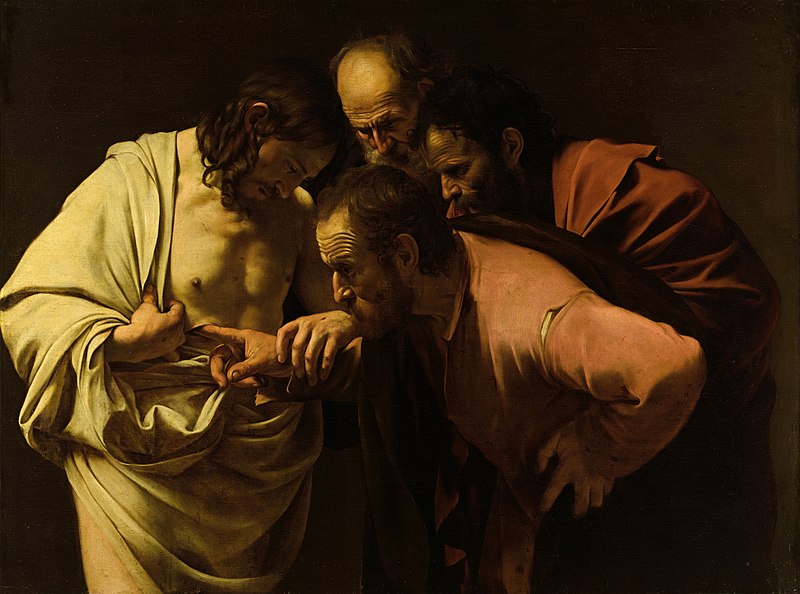
There is a painting titled “The Incredulity of Saint Thomas.” A masterpiece by the Italian Baroque artist Caravaggio, painted in 1601 or 1602.
The religious “Trieste” version of Caravaggio’s “The Incredulity of Saint Thomas” is currently in a private collection, while the secular “Potsdam” version was once part of the Royal Collection of Prussia and is now on display in the Palais at Sanssouci in Potsdam after surviving the Second World War in pristine condition.
This scene depicts the Incredulity of Thomas, the story behind the name “Doubting Thomas,” which has been depicted repeatedly in Christian art from at least the 5th century and is used to illustrate a wide range of theological concepts.
The doubting apostle places his finger into Christ’s side wound in both images, with Christ’s guiding hand.
The unbeliever wears a ragged robe that has been torn at the shoulders and has dirt beneath his fingernails, making him look like a commoner. The picture is composed in such a way that you can feel like you’re there and experience the full force of what’s happening.
It is also worth noting that Christ’s thigh is obscured in the religious version of the Doubting Thomas picture, but is clearly visible in the secular one.
10. David with the Head of Goliath – Caravaggio
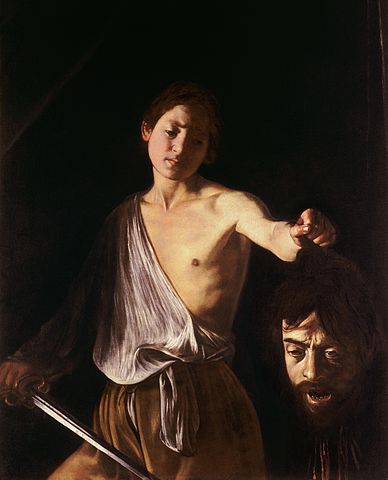
Art historians have long speculated that Caravaggio’s David with the Head of Goliath is actually a self-portrait. Some argue that the young David represents Caravaggio as a child, while the severed and bloody skull of Goliath represents Caravaggio as an adult.
Having been carried there by a penitent Caravaggio pleading with the Pope to lift the price on his head, the painting is currently on display in Rome’s Galleria Borghese. Unfortunately, Caravaggio passed away from a fever not long after learning that the Pope had accepted his request.
He was inspired by a work by a student of Giorgione from 1510 in which a man is shown lounging on a ledge. However, Caravaggio did a better job of conveying the drama by showing David’s head dangling from his gloved hand rather than sitting on a ledge.
In this retelling, David doesn’t utilize the sling that made him famous; instead, he uses Goliath’s own sword to defeat the giant. H-AS OS is an acronym for the Latin phrase “humilitas occidit superbiam,” which translates to “humility slays pride.”

